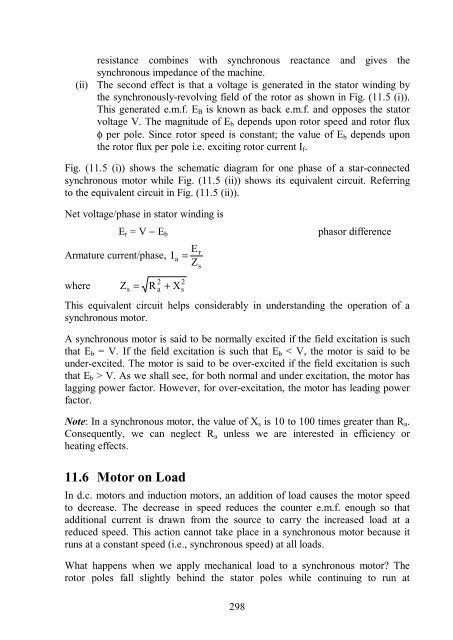Synchronous Motors
Synchronous Motors
Synchronous Motors
Create successful ePaper yourself
Turn your PDF publications into a flip-book with our unique Google optimized e-Paper software.
esistance combines with synchronous reactance and gives the<br />
synchronous impedance of the machine.<br />
(ii) The second effect is that a voltage is generated in the stator winding by<br />
the synchronously-revolving field of the rotor as shown in Fig. (11.5 (i)).<br />
This generated e.m.f. E B is known as back e.m.f. and opposes the stator<br />
voltage V. The magnitude of E b depends upon rotor speed and rotor flux<br />
φ per pole. Since rotor speed is constant; the value of E b depends upon<br />
the rotor flux per pole i.e. exciting rotor current I f .<br />
Fig. (11.5 (i)) shows the schematic diagram for one phase of a star-connected<br />
synchronous motor while Fig. (11.5 (ii)) shows its equivalent circuit. Referring<br />
to the equivalent circuit in Fig. (11.5 (ii)).<br />
Net voltage/phase in stator winding is<br />
E r = V − E b<br />
Armature current/phase,<br />
E<br />
I a =<br />
Z<br />
r<br />
s<br />
phasor difference<br />
where<br />
s<br />
2<br />
a<br />
Z = R + X<br />
2<br />
s<br />
This equivalent circuit helps considerably in understanding the operation of a<br />
synchronous motor.<br />
A synchronous motor is said to be normally excited if the field excitation is such<br />
that E b = V. If the field excitation is such that E b < V, the motor is said to be<br />
under-excited. The motor is said to be over-excited if the field excitation is such<br />
that E b > V. As we shall see, for both normal and under excitation, the motor has<br />
lagging power factor. However, for over-excitation, the motor has leading power<br />
factor.<br />
Note: In a synchronous motor, the value of X s is 10 to 100 times greater than R a .<br />
Consequently, we can neglect R a unless we are interested in efficiency or<br />
heating effects.<br />
11.6 Motor on Load<br />
In d.c. motors and induction motors, an addition of load causes the motor speed<br />
to decrease. The decrease in speed reduces the counter e.m.f. enough so that<br />
additional current is drawn from the source to carry the increased load at a<br />
reduced speed. This action cannot take place in a synchronous motor because it<br />
runs at a constant speed (i.e., synchronous speed) at all loads.<br />
What happens when we apply mechanical load to a synchronous motor? The<br />
rotor poles fall slightly behind the stator poles while continuing to run at<br />
298

















